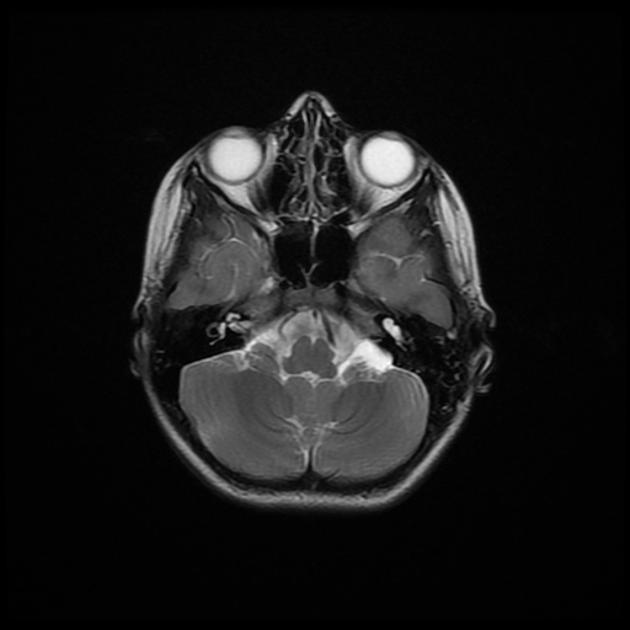Citation, DOI, disclosures and article data
Citation:
Ibrahim D, Bertazzon S, Deng F, et al. Cochlear incomplete partition type I. Reference article, Radiopaedia.org (Accessed on 17 Mar 2025) https://doi.org/10.53347/rID-47545
Cochlear incomplete partition type I (IP-I) is a type of cochlear anomaly associated with sensorineural hearing loss.
CT
As with other types of incomplete partition, the cochlea is clearly differentiated from the vestibule and the external dimensions of the cochlea are nearly normal.
The following are the defining CT features of incomplete partition type I, leading to the name cystic cochleovestibular malformation 1,2:
- cystic appearance of the cochlea due to
- absence of the modiolus including the base/cribriform plate between the cochlea and internal auditory canal (although a thin plate not visible on imaging may be present 5)
- absence of the interscalar septum
- grossly dilated vestibule
This appearance has been likened to a figure 8 morphology 6.
Several features have been associated but are not universal:
- no large vestibular aqueduct 1,4 (with exceptions 3)
- internal auditory canal enlargement 1 (with exceptions 4)
- semicircular canal dysplasia 3 (with exceptions 1)
-
common cavity: the cochlea and vestibule are also cystic but they are not separated
-
incomplete partition type II: the cochlear apex is also cystic but the basal turn is distinctly formed and the vestibule is less dilated
-
1. Sennaroglu L, Saatci I. A new classification for cochleovestibular malformations. (2002) The Laryngoscope. 112 (12): 2230-41. doi:10.1097/00005537-200212000-00019 - Pubmed
-
2. Sennaroglu L, Sarac S, Ergin T. Surgical results of cochlear implantation in malformed cochlea. (2006) Otology & neurotology : official publication of the American Otological Society, American Neurotology Society [and] European Academy of Otology and Neurotology. 27 (5): 615-23. doi:10.1097/01.mao.0000224090.94882.b4 - Pubmed
-
3. Kontorinis G, Goetz F, Giourgas A, Lenarz T, Lanfermann H, Giesemann AM. Radiological diagnosis of incomplete partition type I versus type II: significance for cochlear implantation. (2012) European radiology. 22 (3): 525-32. doi:10.1007/s00330-011-2301-5 - Pubmed
-
4. Adibelli ZH, Isayeva L, Koc AM, Catli T, Adibelli H, Olgun L. The new classification system for inner ear malformations: the INCAV system. (2017) Acta oto-laryngologica. 137 (3): 246-252. doi:10.1080/00016489.2016.1247498 - Pubmed
-
5. Sennaroglu L. Histopathology of inner ear malformations: Do we have enough evidence to explain pathophysiology?. (2016) Cochlear implants international. 17 (1): 3-20. doi:10.1179/1754762815Y.0000000016 - Pubmed
-
6. Joshi VM, Navlekar SK, Kishore GR et-al. CT and MR imaging of the inner ear and brain in children with congenital sensorineural hearing loss. Radiographics. 2012;32 (3): 683-98. doi:10.1148/rg.323115073 - Pubmed citation
-
7. Yiin RS, Tang PH, Tan TY. Review of congenital inner ear abnormalities on CT temporal bone. Br J Radiol. 2011;84 (1005): 859-63. doi:10.1259/bjr/18998800 - Free text at pubmed - Pubmed citation
Promoted articles (advertising)





 Unable to process the form. Check for errors and try again.
Unable to process the form. Check for errors and try again.